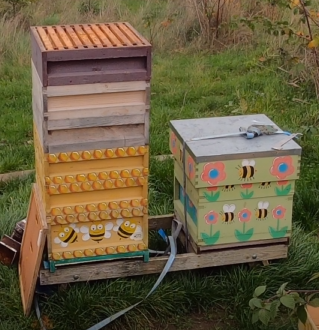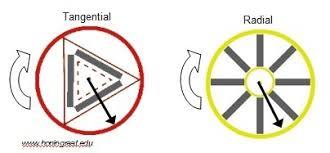New honey extractor
Posted on 20th November 2022 at 16:54
A honey extractor is like a combined harvester in arable farming: You only need it for a few weeks out of the year when it is the perfect too. It costs a fortune and takes up space when not in use. Every now and then you need to upgrade.
Let's see why we need an extractor in the first place. Honeybees are great honey producers.Its in their name. They often produce more honey than they need. The craft of the beekeepers is to harvest the right amount so as to leave sufficient honey on the hive for the bees winter needs.
Not all hive produce a surplus. The hive on the right is being was poorly in the summer and is being fed to bring it up to strength for the winter. The hive on the left has has a very good season and has yielded four supers of honey. A super is the shallow box where the bee store their honey. Count from the top. You will see there are five supers. We will leave one super on the hive. The remainder are the harvest.
The deep box at the bottom of the stack we call (in the UK) the brood box. In the autumn this box is full of honey too. We aim to leave 50/60 lbs (22.6Kg) on the hive for the bees. This is more than enough for the winter. It make no sense to strip the hive of honey. If the bee starve to death over the winter what will one do for a crop next season? Uk beekeepers tend to be conservative withe honey harvest leaving more than is necessary on the hive and in many cases giving them supplementary food as well.


When we get the supers with it's honey laden frames back to our production facility, in my case the "tank room" (there is a story connected with the name. I might tell you later.) in must peoples case it is the kitchen of their house.
The next stage is to remove the capping from the honey comb. This allows the honey to be released from the comb. The photo of is of the kids at Belvoirdale school doing that very process with the frames from the hive at the school.
The uncapped frames are finally put into the extractor.
There are two types of extractor, radial and tangential. Not, as you might imagine, powered and hand cranked although this is a distinction too.
The tangential extractor has the frames arranged at tangent to the centre of the extractor. Because honeycomb is double side it means you ave to stop part way trough the extraction process to turn the frames through 180 degrees to extract the honey from the other side of the frame. Tangential tend to be for a few frames, often three frames occasionally 2 or 4.
The radial extractor has the frames arrange in line with the centre axis of the extractor. This mean honey can be extracted from both sides of the frame at the same time and by spun with greater force. The greater the centrifugal force the more honey that is retrieved from the honeycomb. Radial extractor are most often electrically powered.


And so to my new extractor. It is made by Lyson in Poland. It holds 30 frames, has heated sides and bottom and has 10 ten programs to choose from. These programs spin the frames at different rates over a period of time.
The out going extractor was made by Thomas (a French manufacturer) It has 20 frames capacity, is not heated an has simple manual controls i.e. and on/off switch.
There is a discussion to be had as to why there are no manufactures of honey processing equipment in this country.
I should be able to load the new extractor, close the lid, hit the start button and let the program take care of the extraction cycle. It starts slowly and gather speed. The cycles are somewhere between 30 and 45 minutes. Not only will this allow me to carry on uncapping ready for the next load the heating element will have two additional effects.
1. the honey hitting side of the warm tank will remain warm and runny. It will collect more readily in the bottom of the extractor. Once outside, the warm honey will transit the filters more quickly.
2. The honey being warm and air inside the extractor being warm together with the stepped program leading to higher sustained speed will result in a greater yield of honey.
I expect the new extractor will create new way of working. It has already led to a change in the extraction methodology. Given the efficiency provided by the new kit and the greater yield, It leads me to think I can have more hives because I can handle a more frames more quickly. Or as I view it, more frames with less hassle. The extractor is not too big so I can still maintain extracting honey from specific apiaries and therefore my USP.
Check out my socials for day to day shenanigans, links at the top of the page. You might also check out my Patreon page where for a small sum you can find out what goes on behind the scenes. I share stories and adventure either that never get to the public or you get early notice of. Either way Its all about the bees.
Tagged as: Case study, Misc
Share this post:








